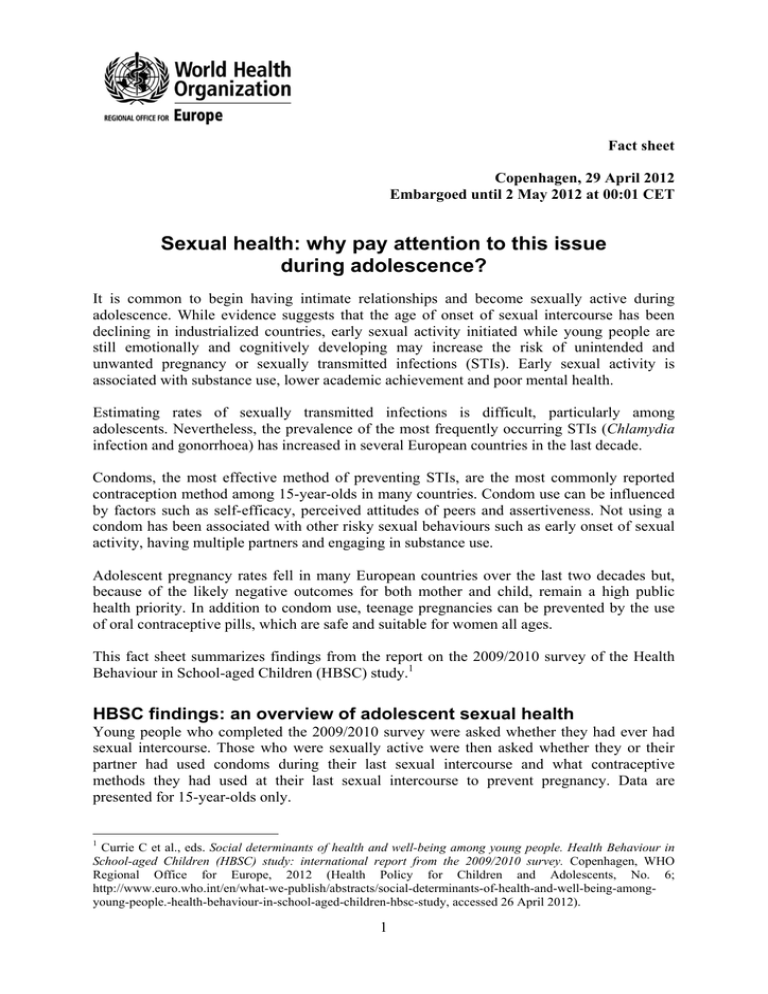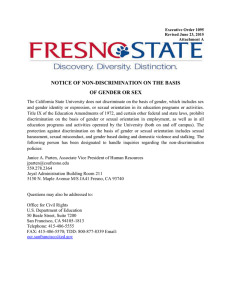Sexual health: why pay attention to this issue during adolescence?
advertisement

Fact sheet Copenhagen, 29 April 2012 Embargoed until 2 May 2012 at 00:01 CET Sexual health: why pay attention to this issue during adolescence? It is common to begin having intimate relationships and become sexually active during adolescence. While evidence suggests that the age of onset of sexual intercourse has been declining in industrialized countries, early sexual activity initiated while young people are still emotionally and cognitively developing may increase the risk of unintended and unwanted pregnancy or sexually transmitted infections (STIs). Early sexual activity is associated with substance use, lower academic achievement and poor mental health. Estimating rates of sexually transmitted infections is difficult, particularly among adolescents. Nevertheless, the prevalence of the most frequently occurring STIs (Chlamydia infection and gonorrhoea) has increased in several European countries in the last decade. Condoms, the most effective method of preventing STIs, are the most commonly reported contraception method among 15-year-olds in many countries. Condom use can be influenced by factors such as self-efficacy, perceived attitudes of peers and assertiveness. Not using a condom has been associated with other risky sexual behaviours such as early onset of sexual activity, having multiple partners and engaging in substance use. Adolescent pregnancy rates fell in many European countries over the last two decades but, because of the likely negative outcomes for both mother and child, remain a high public health priority. In addition to condom use, teenage pregnancies can be prevented by the use of oral contraceptive pills, which are safe and suitable for women all ages. This fact sheet summarizes findings from the report on the 2009/2010 survey of the Health Behaviour in School-aged Children (HBSC) study.1 HBSC findings: an overview of adolescent sexual health Young people who completed the 2009/2010 survey were asked whether they had ever had sexual intercourse. Those who were sexually active were then asked whether they or their partner had used condoms during their last sexual intercourse and what contraceptive methods they had used at their last sexual intercourse to prevent pregnancy. Data are presented for 15-year-olds only. 1 Currie C et al., eds. Social determinants of health and well-being among young people. Health Behaviour in School-aged Children (HBSC) study: international report from the 2009/2010 survey. Copenhagen, WHO Regional Office for Europe, 2012 (Health Policy for Children and Adolescents, No. 6; http://www.euro.who.int/en/what-we-publish/abstracts/social-determinants-of-health-and-well-being-amongyoung-people.-health-behaviour-in-school-aged-children-hbsc-study, accessed 26 April 2012). 1 Across HBSC countries and regions, by the age of 15, an average of 29% of boys and 23% of girls are sexually active (see figure). Cross-national differences European and North American countries show large differences in rates of contraceptive pill and condom use among adolescents. In particular, while contraceptive pill use is low across all countries there is a clear geographical pattern. Adolescents from northern and western Europe report the highest contraceptive pill use, while rates are lowest in southern and eastern Europe. Acceptance of sexual activity may be broader among those with higher pill use (linked to culture, religion, politics and economics), which enables better access to contraception and sexual health services for young people. Gender In around half of the countries, boys were significantly more likely to report having had sexual intercourse. The greatest gender disparity was observed in Armenia, Greece and eastern European countries. In some countries, the gender trend is reversed, with more girls than boys reporting having had sexual intercourse. This occurs mainly in northern and western Europe, perhaps reflecting an erosion of gender stereotyping in more permissive cultures. Boys are more likely than girls to report condom use at last sexual intercourse, possibly as they feel less embarrassed buying and/or carrying them. The fact that boys do not always know whether their partner uses the contraceptive pill may explain the tendency for girls to report the use of oral contraceptives at last sexual intercourse more frequently. Condoms and the pill are the most popular methods of contraception among adolescents, but dual contraception (pill and condom) is not common among young people. Family affluence With regard to early sexual experience, family affluence was only a significant factor in a few countries. In those countries where family affluence was significant, boys from low-affluence households were more likely to have early sexual experience, whereas the opposite trend is observed for girls. How policy can help It is essential to promote safer sexual behaviour through education and services that 2 guarantee access to information, contraceptive services and confidentiality. Integrative programmes involving schools, community and health-care settings are most likely to be effective in realizing these goals. Early implementation of comprehensive sexuality and relationship education is recommended, as it is more likely to be effective if delivered before young people commence sexual activity. Communication and negotiation skills regarding how and when to first engage in sexual relationships may form an important part of effective sexuality and relationship education, as it can enable young people to refrain from engaging in sexual relationships before they are ready. Different messages may be needed for boys and girls within programmes that focus on the use of contraceptives, since the reasons for, and barriers to, carrying and using condoms may differ between the genders. Boys are more receptive to messages relating to HIV/AIDS, while girls are more likely to respond to pregnancy prevention interventions. WHO has identified shortcomings in the availability and/or suitability of adolescent-specific health services in various countries. Inequity in service provision based on age may prevent young people from seeking contraceptive advice before engaging in sexual activity. Services providing help and advice on the use of condoms and other contraceptive methods should be available to young people of all ages. These should be accessible and confidential, with staff trained in the specific needs of adolescents. In addition to comprehensive sexuality and relationship education and the provision of adolescent-friendly services, broad youth development programmes that target social exclusion by developing self-esteem and providing educational support and vocational preparation are effective in countering potentially negative outcomes of early sexual initiation. In 2010, the Regional Office and the German Federal Centre for Health Education (BZgA) jointly published Standards for sexuality education in Europe: a framework for policy makers, educational and health authorities and specialists.2 2 Standards for sexuality education in Europe: a framework for policy makers, educational and health authorities and specialists. Copenhagen, WHO Regional Office for Europe and Cologne, Federal Centre for Health Education, 2010 (http://www.bzgawhocc.de/?uid=072bde22237db64297daf76b7cb998f0&id=Seite4486, accessed 25 April 2012). 3 For further information, contact: Technical information: Media enquiries: Vivian Barnekow Programme Manager, Child and Adolescent Health and Development Division of Noncommunicable Diseases and Health Promotion WHO Regional Office for Europe Scherfigsvej 8, DK-2100 Copenhagen Ø, Denmark Tel.: +45 3917 1410 E-mail: vbr@euro.who.int Tina Kiær Information Officer, Division of Noncommunicable Diseases and Health Promotion WHO Regional Office for Europe Scherfigsvej 8, DK-2100 Copenhagen Ø, Denmark Tel.: +45 39 17 12 50, +45 40 87 48 76 (mobile) E-mail: tki@euro.who.int 4



